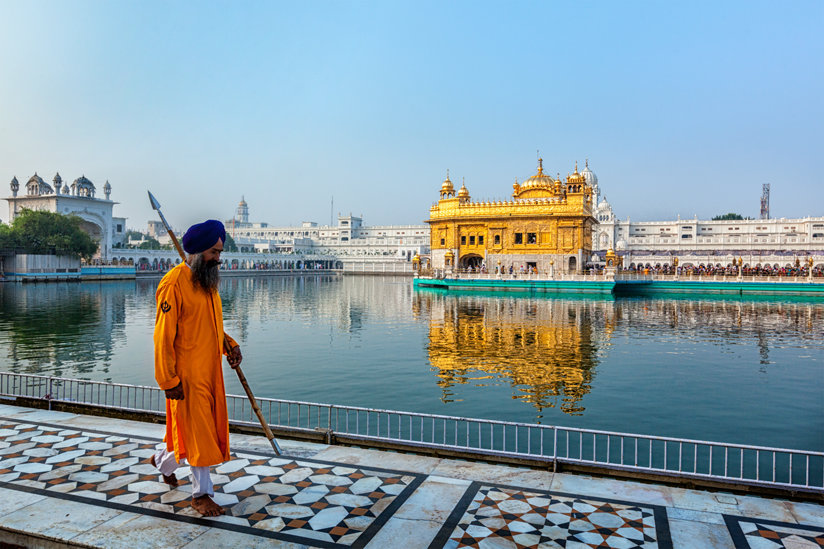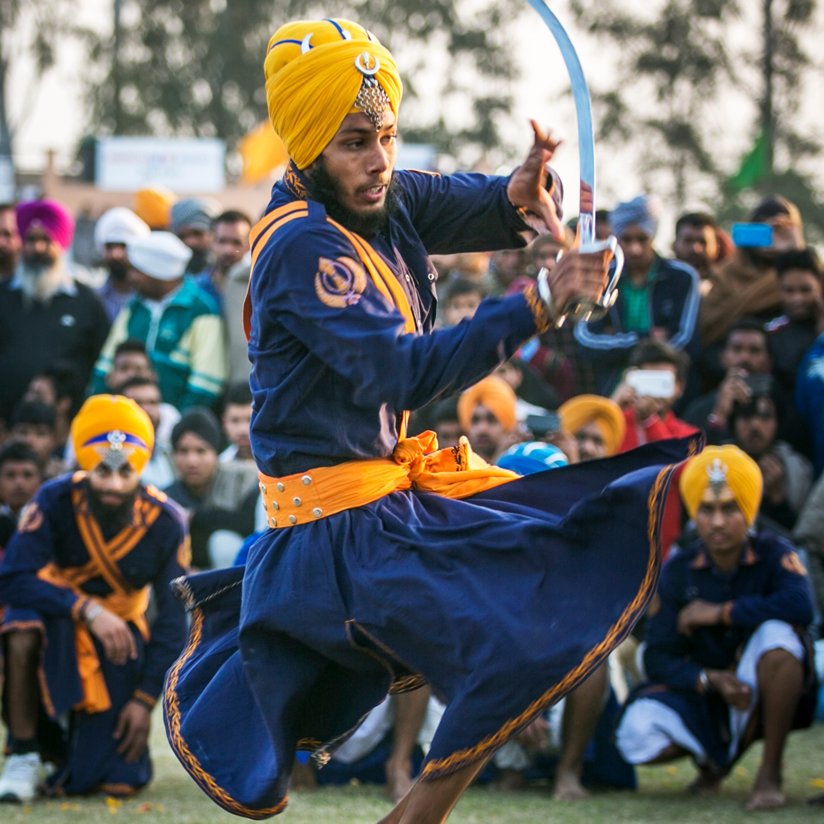Sikhism: A Phoenix Rises From the Ashes of Suppression
Many of the Sikhs I’ve seen wear a countenance of peace and benevolence while also wearing a sword on their belt. That contradiction always interested me, and my curiosity finally got the better of me. I looked and discovered that Sikhism, the world’s fifth largest religion (and one of the youngest) is very different from most other religions. But, like other religions, to understand Sikhism you have to understand its history.
Sikh means “seeker of truth.” By the 15th century, India had become mired in such a toxic brew of intolerance and sectarianism that truth would have been hard to find.

(Photo by Dmitry Rukhlenko/Shutterstock.com)
Sikh Origins and History
It was the late 1400s in India. Religious fanaticism combined with the caste system to create a culture where the ruling Mughals could and did round up commoners and slaughter them solely to slake their royal hounds’ thirst for blood. Death awaited the careless soul who sat next to a person of a higher caste. Anyone who refused conversion to Islam faced torture and death. There was no recourse. For those who survived the Mughals’ oppression, ordinary life consisted of violence, starvation, and disease.
In the midst of this bleak landscape, a man had a vision.
Guru Nanak (1469-1539)
In Sikhism, a Guru is anyone or anything that leads the individual from darkness into the light of eternal understanding. At its root the word is derived from Gu (darkness) and Ru (light). Guru Nanak, the first Sikh guru, had been pursuing the divine since age 5. According to legend, he was 30 years old when he disappeared into a river where he meditated for three days. He emerged with a new concept of reality, one in which every person regardless of caste, gender, creed or nationality, carried equally within them the divine spark.
Unlike the multitheism of Hinduism in which he had been raised, Guru Nanak realized that there is one God of this creation, and that because we all come from that one God, we are all equal; that the light of that God flows through all beings, no matter how they choose to worship. From this postulate, an intense belief in the brotherhood of all people flourished. With this awareness, he believed that everyone could live a life of love, truth, patience and serenity.
He recorded his vision in a song, Japji Sahib, the Song of the Soul. This song became the foundation for a new religion which sought to free men from the tyranny of their day-to-day existence.
Guru Nanak traveled throughout India, Asia and Persia, sharing his song, his vision.
To the Guru Nanak, ultimate truth was revealed by becoming attuned to the sound of the Universal Wisdom (Shabad), the sound that calls the soul home. His songs were his recordings of that divine sound, rendered in a form which others could hear, allowing them to meditate and achieve oneness with God.
For the next 209 years, his vision flourished under the guidance of nine subsequent gurus. Each added uniquely to the syllabus of song and belief that became Sikhism, which Guru Nanak had founded.
Guru Angad (1504-1552)
Guru Nanak selected Guru Angad to carry on his legacy, establishing a tradition of bequeathing the guruship to a chosen successor. That tradition would determine the successorship for most of the gurus to follow. Guru Angad added his own divine songs to the growing literature of Sikhism. But most importantly, he provided a written guide that allowed people to more accurately replicate his songs, the songs of Guru Nanak, and the songs of mystics from other lands and languages that Guru Nanak had collected. With his wife, Guru Angad instituted the tradition of langar—the community meal where, in direct contravention of the rules of Indian culture, people of all castes ate together.
Guru Amar Das (1479-1574)
Guru Amar Das contributed his own songs of the eternal to the Sikh anthology. He composed the Anand Sahib, the Song of Bliss, and expanded on the tradition of langar. He taught humility, service, dedication, equality, honor and respect to women.

Guru Ram Das (1534-1581)
Guru Ram Das composed several songs, including the Lavaan, the Sikh wedding ceremony. He founded the city of Amritsar and began building the most sacred of all Sikh temples, the Harimandir Sahib (Golden Temple). The waters surrounding this temple are renowned for their healing properties, while the building itself has four doors—one on each side—to symbolize its availability to persons of every caste, religion, language and culture.
Guru Arjan (1563-1606)
Following in the footsteps of his father, Guru Ram Das, Guru Arjan completed construction of the Golden Temple. He compiled the sacred songs of all previous Sikh gurus, as well as songs from Hindu and Sufi mystics, and added his own sacred writings. Guru Arjan taught that the songs themselves, not the man, were the real teacher.
During his lifetime, the Sikh community prospered. This prosperity brought the attention of the Mughal emperor, Jahangir, who challenged the sovereignty of Guru Arjan and his people. In response, Guru Arjan surrendered himself to the emperor. According to Sikh legend, the emperor tortured Guru Arjun because he refused to convert to Islam. The emperor chained Guru Arjan to a hot metal plate and poured burning sand over his body. For five days and nights the torture continued, but Guru Arjan was unbroken. He saw the hand of the divine in all things, and to the consternation of his captors, he smiled at them through the entire ordeal. On the sixth day, he was unchained, so that he could bathe in a nearby river. Guru Arjan walked to the river, dove in and dissolved into light.
Guru Hargobind (1595-1644)
Since its inception, the Sikh tradition had been rooted in peace and meditation. With the death of Guru Arjan, that would change. Guru Hargobind, Guru Arjan’s son, saw the need for Sikhs to be able to defend themselves. To answer this call, he created the Sikh martial art known as the gatka.
Gatka remained consistent with Sikh tradition. The Sikh warrior would only defend—never attack. In the centuries that followed, Sikh warriors became famous for protecting the rights of others to practice their religious beliefs in peace. They defended those who could not defend themselves.

Guru Har Rai (1630-1661)
The martial times of Guru Hargobind morphed into peace and prosperity under his grandson, Guru Har Rai. Guru Har Rai was a healer and herbalist. He kept a large garden from which he developed his medicinal wares. Sikhism prospered under his healing touch.
Guru Har Krishan (1656-1664)
Guru Har Krishan was named guru at the age of 5 by his father, Guru Har Rai. Some in the Sikh community doubted the ability of a 5-year-old to lead them. One, a man named Lal Chand, challenged the boy to a scriptural debate. Guru Har Krishan told Lal Chand to find someone in the town who would debate on the guru’s behalf. Lal Chand found a deaf mute, an illiterate water-carrier, and presented the man to the guru. Guru Har Krishan touched the head of the water carrier who promptly awoke and himself gave a profound lecture interpreting Sikh scripture. Lal Chand begged forgiveness from the boy. It was the last time Guru Har Krishan would be challenged. In 1664, the Guru went to Delhi to assist the victims of a smallpox outbreak. Guru Har Krishan’s body succumbed to the disease when he was merely 8, although not without naming a successor, Guru Teg Bahudar.
Guru Tegh Bahadur (1621-1675)
Guru Tegh Bahadur traveled extensively, establishing new Sikh communities and contributing his own songs of the divine. But in the early 1670s, the Mughal emperor Aurangzeb launched a brutal campaign of forced conversion on all non-Muslims. Hindu leaders were ordered to choose between Islam or torture and death. Guru Tegh Bahadur interceded on their behalf. He offered the emperor a choice—convert him, and all of the Hindu leaders would accept Islam. Fail, and the emperor would have to leave the Hindus in peace. The emperor agreed.
At the appointed time, the Guru, along with three companions, entered the emperor’s prison. The tortures that followed killed his companions, but not the Guru. Repeatedly, the emperor asked him to produce a miracle to show that he was a holy man, but the Guru refused. Instead, he would ask his guards, “Why are we spending our time together this way? We could be meditating and praying together, instead.” The emperor gave up trying to convert the Guru, but instead of keeping his word, the emperor had Guru Tegh Bahadur beheaded.
After his death, a letter was delivered to the emperor. It was written by the Guru before he had entered the prison. It stated simply, “This, then, is the greatest miracle. That I gave my head, but not my faith.”
Guru Gobind Singh (1666-1708)
Guru Gobind Singh was the son of Guru Tegh Bahadur. He was only 9 when he learned of his father’s confinement, torture and death. The horror of that experience guided his life, leading him in 1699 to a hill in Anandpur where he called for a gathering of Sikhs.
There, in crisis, he faced a multitude of his people. These were extraordinary times, and to challenge his people’s faith, Guru Singh employed extraordinary measures. He unsheathed his sword and demanded, “Who will be the first to sacrifice their head?” None answered his call. He repeated his demand. Still no one moved. Upon his third call, a man named Daya Ram stood and offered his head to the Guru’s sword. The Guru led Daya Ram into a tent, from which only the Guru and his bloody sword emerged.
“Who else will sacrifice their head?” Another volunteer. Another trip to the tent from which only the Guru and his bloodied sword emerged.
The grisly ceremony repeated three more times, to the increasing shock of the peaceful crowd.
Guru Gobind Singh then signaled, and from the tent emerged the five men, unharmed. They became known as the Panj Pyare (the “beloved five”), and formed the foundation of the Khalsa (meaning, “to be pure, to be clear, to be free from”), the warrior class of Sikhs. The Khalsa were charged with defending the innocent from any form of religious persecution.
Over the next nine years, the Khalsa fought many battles against the emperor who had killed Guru Singh’s father. Guru Singh’s four sons were captured and slain—the eldest two in battle, the youngest two were entombed alive inside a wall. They joined thousands of Sikh faithful who were martyred by India’s early 18th-century rulers.
Nearing the end of his life, Guru Gobind Singh wrote a letter to Emperor Aurangzeb. In it, he enumerated the atrocities committed in the emperor’s name. Aurangzeb was reportedly shocked by the contents of the letter, and promptly ceased the campaign of slaughter against the Sikhs. The Guru had won.
The Khalsa remains to this day as a revered order within Sikhism. It is the basis of the Sikh tradition of wearing a small sword on one’s belt.
Guru Gobind Singh had not confined himself to fighting oppression. During his life, the Granth Sahib—the holy book of scripture for the Sikh faith—was completed. It was a 1,430-page compilation of the songs and teachings of six of the Sikh gurus, as well as contributions from 30 members of other religions from different times.
To many westerners, guru means “teacher,” an enlightened person who shows others the way. In Sikhism, guru means “that which takes you from darkness to light.” It may be an individual. It may be a song. It may be a scripture. It may involve a sudden flash of insight, or it may manifest as an enduring state of grace.
In 1708, facing the death of his body, the Guru Gobind Singh declared that, from that day forward, the guruship for the Sikh people would be the responsibility of the Granth Sahib (hereafter the Guru Granth Sahib) the holy scriptures of Sikhism. No longer would Sikhs look to an individual as a physical embodiment of the guru. The task of guiding the individual to awareness of the eternal would be realized through the individual’s own study of the Guru Granth Sahib. The sounds of the eternal, which Guru Nanak first heard and which were captured in the songs recorded in the Granth Sahib, would henceforth serve as the sole spiritual light and guide for the Sikh people.
Banda Singh Bahadur (1670-1716)
Following the death of Guru Gobind Singh in 1708, the guruship of the Sikh people would no longer be in the hands of an individual. Through study and worship, every Sikh faithful held the means of controlling their own divine learning. Nonetheless, the Sikh people still needed a leader. In 1708, Banda Singh Bahadur stepped into that role and continued the Sikh fight for freedom from Mughal oppression. He put an end to a local system of feudal control, returning proprietorship of land to the farmers who lived and worked there. But in 1715, he and his followers were surrounded by the invading army of Mughal ruler Samad Khan. For eight months they resisted capture until starvation forced their hand. Khan rode back into Delhi displaying 700 cartloads of Sikh heads, with an additional 2,000 Sikh heads hanging from the spears of his soldiers. Those Sikhs who had been captured alive were executed at the rate of 100 per day, until Banda Singh Bahadur was all that remained. His eyes were gouged, his limbs severed, and his skin removed before he was killed.
The Sikhs retreated to the jungles, only to return after a series of military victories two decades later. The history of armed defense of their religion continued up through British rule, during which the Sikhs achieved a camaraderie with the British, often fighting together.

Sikhism Today
Today, Sikhism is the world’s fifth largest religion with some 26 million adherents.
Sikhism is most prominent in the Indian state of Punjab, where Sikhs are in the majority. But Sikhs have migrated all over the world—to East Africa, West Africa, the Middle East, Southeast Asia, the United Kingdom, the United States and Australia.
Sikh Practices and Beliefs
Sikhs hold that there is but one God, a God who is worshipped in many and diverse ways through the practices of many religions. Thus, Sikhs feel a brotherhood with men of all faiths. They believe that distinctions based on caste, gender, race or creed are false. They reject rituals. They do not proselytize. They hold women in high regard. Female infanticide, wife-burning, the masking of women, and a prohibition of remarriage are all firmly rejected. On the contrary, women are considered the grace of God on Earth. Family life is revered.
The purpose of human existence is to break the cycle of birth, death and rebirth (“Samsara”) and become one with God.
This is accomplished by studying and following the teachings, and singing the songs of the Guru Granth Sahib; by prayer and meditation; by productive work (the proceeds of which are shared with others); and by performing selfless acts of service and charity.
The Guru Granth Sahib, the most sacred of Sikh religious texts, is available to anyone to study for themselves. It can even be bought on Amazon.
The spiritual practice of the Sikhs is to sing, or chant (aloud or to oneself), the songs contained in the Guru Granth Sahib. There are 61 songs, set to 31 different musical scales. They were written by six of the Sikh gurus and 30 non-Sikhs. Different songs are suitable for different times of day and different seasons.
Through these songs, the individual can harmonize with the eternal spirit, connect with God, and achieve liberation.
The five cardinal vices of Sikhism are (1) Kam (lust); (2) Krodh (anger); (3) Lobh (greed); (4) Moh (worldly attachment); and (5) Ahankar (pride). Significant prohibitions within Sikh culture include (1) haircuts (this includes trimming beards), since hair is considered to be a manifestation of life and thus sacred (Sikhs often protect it with a turban); (2) intoxication (alcohol or drugs); (3) gambling; (4) eating certain kinds of meat; (5) extramarital sexual relations.
Sikh festival days include:
- Vaisakhi (the Sikh new year festival)—a holiday celebrating Guru Gobind Singh’s creation of the Khalsa, the Sikh fighting force. It is generally held on April 13 or 14.
- Nagar Kirtan (“Neighborhood Singing of Divine Hymns”)—a day devoted to a processional singing of songs from the Guru Granth Sahib. It usually occurs in the first week of November.
- Bandi Chhor Divas (“Day of Liberation”)—a day to celebrate Guru Hargobind’s release from the Mughal prison. It is celebrated on the same day as the Hindu holiday of Diwali (this year, November 14), with lights, fireworks and festivities.
- Hola Mohalla (“Mock Fight”)—a three-day celebration of the Sikh martial art of gatka which includes archery and martial competitions. This year, it was held March 29-31.
- Gurpurbs (“Guru Days”) fall throughout the year and are days of celebration of the ten Sikh gurus and martyrs.
Sikhism has a remarkably violent history. The demands of that history prompted Sikhs to develop expertise in war, a skill that was used primarily in defense. As a result, they controlled their own destiny; they survived. It is in recognition of their right to control their own destiny that Sikh faithful wear a sword, and it is an expression of the nature of that destiny that they present a peaceful and benevolent countenance.
Now I understand.
For more information about Sikhism, visit www.sikhcoalition.org.










